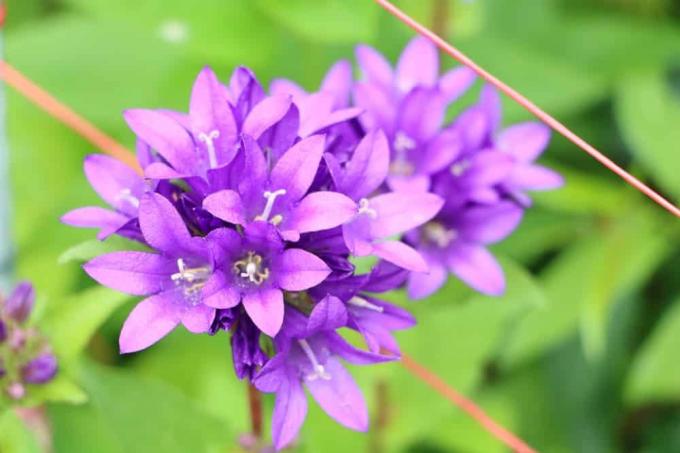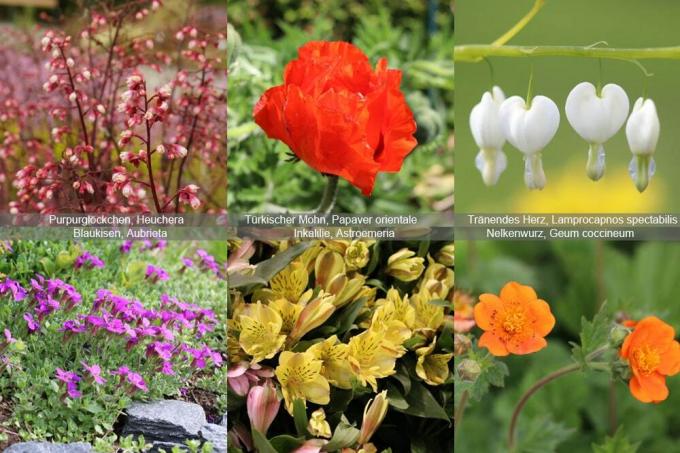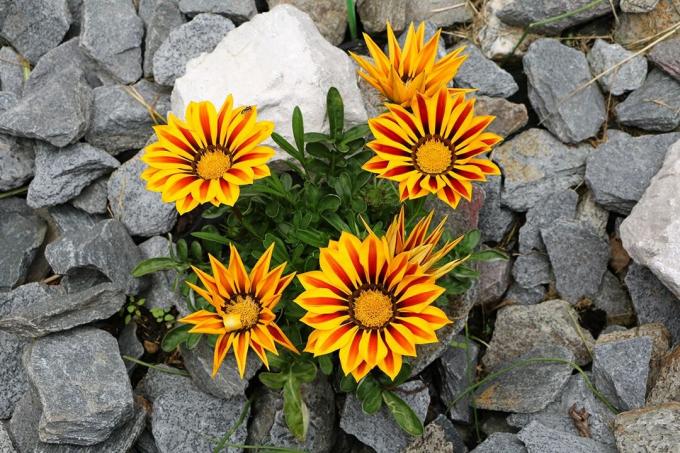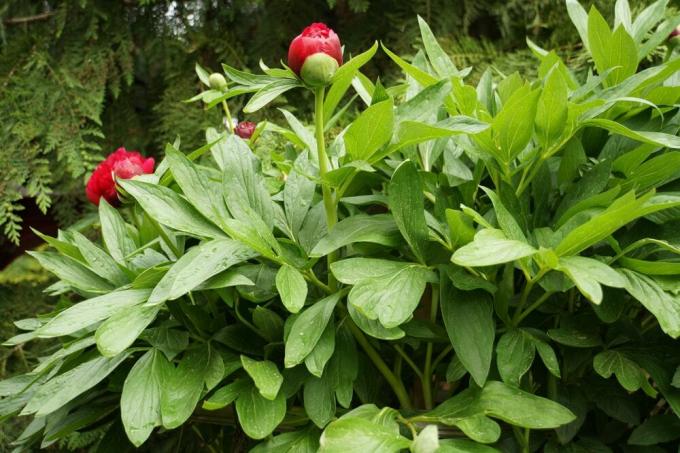

Table of contents
- Summer perennials: The specialists for colorful splendor
- The hardiness of summer perennials
- Garden design with perennials from A-Z
You could no longer carry a list of all summer flowers in book form, if you subtract the few flowering wonders that have been mutated into annuals through breeding, they are all summer perennials - in the Article selected examples of beautiful summer perennials are presented to you, cultivars with particularly brilliant colors from A-Z and types of flowering perennials sorted by design purpose. In addition to various selection criteria, the most important basic ideas for creating a planting plan are explained You will also be informed about how to get to the bottom of the winter hardiness of summer perennials go:
Summer perennials: The specialists for colorful splendor
Summer perennials provide the loveliest blooms of the garden season, in any color you desire. A number of cultivars are presented below that have become known for their particular color brilliance of the flower.
Tip:
Where things were sorted from A-Z here, this was done with reference to the botanical names of the plants, which do not conjure up a smile of recognition on the lips of every hobby gardener. Nevertheless, if you want to know what you are buying, there is no other way: A plant can only be clearly identified by its botanical name. Native plants are often called differently in the local language in each region, and foreign guests often combine several trade names and colloquial names. If you find out about the botanical names of plants to be purchased soon, it will not only help you to find out about winter hardiness, a harmless "sunflower" e.g. B. can turn out to be a one-year-old monster, mutate into a horrid plant that conquers the garden with its runners, or do what they probably want from her: Perennial growth in the assigned place (and only there) and decorative flowers every year bring forth.
Soft pastel: Cream to pink
- Arabis arendsii 'Compinkie', goose cress with pink flowers April to May
- Antennaria dioica 'Rubra', Cat's Paw, flowers pink-red from May to June
- Heuchera micrantha 'Plum Pudding', purple bells, light pink flowers from June to August, red leaves
- Papaver orientale 'Queen Alexandra', Turkish poppy with creamy pink summer flowers
- Saxifraga urbium 'Clarence Elliott', pink porcelain flowers for early summer beds
Rich to fiery Red
- Heuchera hybrid 'Firebird', the purple bells blooms dark scarlet in May to June
- Monarda 'Prairie Night', the bee balm flowers deep crimson from July to September
- Papaver orientale 'Beauty of Livermere', a Turkish poppy that flowers fiery red in May/June
- Paeonia officinalis 'Rubra Plena', the peony shows a blood-red double flower in May
- Pulsatilla vulgaris 'Röde Klokke', a pasque flower with dark red flowers from March/April
shimmering White
- Anaphalis triplinervis 'Summer Snow', pearl button, snow-white flowers in June/July
- Campanula glomerata 'Alba', clustered bellflower with many white flowers May to June
- Cerastium tomentosum 'Silver Carpet', Fuzzy Carpet Hornwort, shows dull white flowers in May to June
- Chrysanthemum leucanthemum 'Maikönigin', meadow marguerite with white May flowers
- Dianthus deltoides 'Alba', Carnation, flowers white with traces of pink in June
- Dicentra spectabilis 'Alba', bleeding heart with pure white flowers May to June
- Omphalodes verna 'Alba', spring umbilicus with white flowers from March to May
Screaming Magenta, pink, purple
- Aubrieta hybrid 'Royal Red', blue cushion with magenta spring bloom
- Centranthus ruber 'Coccineus', spur flower, flowers June to September crimson pink
- Lychnis viscaria 'Plena', a common pitcher with bright pink flowers
- Phlox subulata 'Temiskaming', cushion phlox with purple flowers April to May
- Pulmonaria rubra 'Dora Bielefeld', garden lungwort with bright pink flowers from April
Sensual purple to violet
- Ajuga reptans 'Atropurpurea', creeping bugle with light purple flowers April to May
- Aubrieta hybrid 'Dr. Mules', blue pillows with deep purple spring blooms
- Astilbe 'Anita Pfeiffer', splendor, flowers salmon pink from June to August
- Geranium x magnificum 'Rosemoor', cranesbill, blue-violet flowers from May to July
- Iris sibirica 'Red Flame', Siberian iris, purple-violet flowers May-June
- Origanum vulgare 'Compactum', oregano, flowers light purple from June to September
sunny yellow
- Alyssum montanum 'Berggold', mountain stone herb with bright yellow spring flowers
- Epimedium perralderianum 'Frohnleiten', elfin flower, shows rich yellow flowers from March/April
- Helianthemum hybrid 'Sterntaler', gold-yellow flowering rockrose from May to September
- Hemerocallis hybrid 'Corky', daylily with golden yellow flowers in June
- Lamiastrum galeobdolon 'Florentinum', common golden nettle, shows pale yellow flowers from May
- Rudbeckia fulgida 'Goldsturm', Coneflower, has golden yellow flowers with a black center in July to September
Spherical to sparkling blue
- Aubrieta hybrid 'Royal Blue', blue cushion with more blue-violet than royal blue spring blooms
- Aquilegia hybrid 'Blue Tones', Columbine, intense blue flowers from May to June
- Geranium himalayense 'Gravetye', Himalayan cranesbill with bright blue flowers from May
- Iris Barbata Nana hybrid 'Coerulea', bearded iris with light blue flowers April to May
- Phlox subulata 'G. f Wilson', cushion phlox with purple-blue flowers April to May
- Pulmonaria angustifolia 'Azurea', narrow-leaved lungwort with sky-blue flowers from March to May
- Veronica austriaca teucrium 'Royal Blue', clump speedwell with royal blue flowers May to June
Bright orange
- Alstroemeria aurea 'Orange King', Alstroemeria with orange-yellow flowers July to August
- Echinacea hybrid 'Big Sky Sunset', coneflower with bright orange flowers July-October
- Geum coccineum 'Borisii', this red avens flowers orange-red in May to June
- Kniphofia 'Candy Apple', torch lily with bright orange flowers July to September
- Trollius chinensis 'Golden Queen', globe flower with yellow-orange flowers June to July

Tip:
Each cultivar belongs to a perennial species, and that perennial species usually has other cultivars to offer. Sometimes an unbelievable number of different shades of a few flower colors or in many different colors. You should look around at the other varieties of a species, especially if you want to cover your garden with a kind of tone-on-tone painting. If you want it to be really colorful, you need cultivars with different flower colors or different types of perennials. If the selection is not enough for you: Onion flowers are also perennials.
The hardiness of summer perennials
Whether a perennial survives the winter in your garden depends on its origin and rearing.
There are the following options:
1. The native perennial usually does not cause any problems during the winter (and not otherwise). It is not about hardiness, this term makes statements about how a plant imported into a foreign climate will cope with the winter in that foreign climate. But about frost hardness, the ability of the plant to deal with the sub-zero temperatures that occur in its homeland.
Plants that are native to the same climate also show potentially serious differences in this regard: frost-sensitive natives can cause problems in frost-prone locations. However, native perennials are among the robust, frost-resistant representatives of the native flora and will only disappoint you in rare exceptions.
2. A plant was imported from a foreign country whose climate is almost like ours. Then there are facilities for dealing with winter cold, which can be expanded through breeding. If the plant was imported some time ago, there are very likely already several cultivars that have no problems with the German winter cold.
3. From plants from hot regions, z. B. get to know a bit of cold on a mountain (or even get to know tropical plants), "hardy" cultivars are offered. Sometimes it is possible to improve the winter hardiness somewhat through a long period of breeding selection, then this special feature is pointed out when purchasing such cultivars. Sometimes plants that are obviously not native to us are advertised as hardy without further information. Then it is worth asking in which part of the world this plant is hardy.
Information on winter hardiness, origin and rearing should be requested or obtained when purchasing. be provided on a label. The winter hardiness is given internationally in USDA hardiness zones, Germany has the hardiness zones 6 to 8, the You can find out your home town's hardiness zone at your local nursery (and if they no longer exist, probably at their environmental agency).
Tip:
The terms "frost hardiness" and "winter hardiness" are often used synonymously and also go into each other insofar as that a plant that is sensitive to frost in its homeland is unlikely to be the leader in terms of winter hardiness abroad mutated. So the whole area hardiness/frost hardiness is a bit complicated. You can get rid of problems with cold-weakening plants of any origin once and for all, if you follow this advice consistently: Buy from a local nursery that sells the plants locally raises. What has been pulled a few miles away from you and properly hardened to survive the winter cold should be in your backyard already come across an extremely unfavorable microclimate in order to have problems with the cold (which will then certainly be discussed as part of the advice on the location).
Garden design with perennials from A-Z
Experience has shown that once a gardener has discovered perennials for himself, the garden will fill up with more and more perennials over time. If you plant each perennial area with a thoughtful planting plan, you will eventually have one blooming garden throughout the season that is easier to maintain than any other imaginable Planting.
This is what matters when planting flowering perennial areas:
1. First select key plants

The gardener calls the tall perennials with expressive flowers, which dominate the effect of the bed, leading plants or scaffolding plants. These magnificent perennials should immediately catch the eye, so they get the best place in the bed. Not in large numbers, this will weaken the effect of the key plants rather than increase them. As scaffolding plants z. B. Perennials of the following genera/species are often used:
- Astilbes, spars
- Cimicifuga, silver candles
- Delphinium, Larkspur
- Echinacea, Coneflower
- Eremurus, steppe candles
- Lilium, lilies
- Paeonia, Peonies
- Papaver orientale, Turkish poppy
- Phlox, flame flowers
2. Assign companion plants
After you have decided who the stars in the bed are, you have to decide whether the stars should be courted harmoniously or in contrast. Depending on this, the companion plants are selected, which are moderately conspicuous, but extremely easy to care for, grouped around the guide plants and determine the area of the bed.

They should be less conspicuous than the leading plants and have a slightly lower growth height, here are a few examples from the large selection:
- Aquilegia, Akelein
- aster, asters
- Bergenia, Bergenia
- Coreopsis, girls eyes
- Dianthus, carnations
- Dicentra, Bleeding Heart
- Echinacea, Coneflower
- Hemerocallis hybrids, daylilies
- Pelargoniums, geraniums
3. Gap filler – for individual charisma
Lead and companion plants together make a regulation flowering perennial bed - which looks a bit like the bed at Park entrance, in front of the castle, in the raised planting strip in the pedestrian zone, because these beds are also regular and in accordance with the regulations were created.
The private house garden is better off if a little individual charisma is added. Where there is still space, it is filled with one of the following perennials:
- Wide-growing, flowering area cover such. B. Wood anemone, asters, creeping bugle, dwarf yarrow
- Flowering leafy perennials such as various heucheras, hostas or silver leaf sage
- Perennials with added value, royal lilies and magnificent saplings decorate vases in the living room, rose blossoms and sage taste good, also as tea
- Summer perennials with lavish abundance of flowers, as such z. B. known as goldenrod, lupins, peonies, phlox and hollyhocks
- Ornamental grasses and co. such as cortaderia (pampas grass), miscanthus (chinese reed) for a lively background
Tip:
The more value you place on individuality, the more you should pay attention to “breaks” in the design with the gap fillers to incorporate: sudden surprises, colors that don't quite match, a little wild disorder, inharmonious ones height jumps. If you place a lot of value on individuality, do not orientate yourself at all on the rule of leading plants/companion plants, but plan your very own design from the outset, e.g. B. with uniform areas of different heights or a picture of variegated perennials of the same species.
 garden editorial
garden editorial I write about everything that interests me in my garden.
Learn more about flowers

Midday gold, Gazania: proper care and wintering
The midday gold, which impresses with its colorful and sun-loving flowers, is one of the most popular perennials for local gardeners. The right tips for caring for and overwintering the Gazania have been put together for you here.

Caring for, overwintering and cutting asters | Instructions
The radiant flowers of the asters enchant every garden as well as in pots, terraces and balconies, depending on the variety, from May until well into autumn. Caring for the perennials is not that difficult if everything is known about wintering and cutting.

Magnificent pier, Astilbe: care instructions from A - Z
Astilbe is very popular in the garden. Still, gardeners need to consider a few things if they want the plants to thrive. In our A-Z care instructions, you will learn everything you need to know about the splendor, from flowering to winter protection.

California Poppy, Eschscholzia californica: Care Instructions
Hardly any garden plant is as easy to care for as Californian poppy (Eschscholzia californica), which, with its golden yellow flowers, is a feast for the eyes in the home garden. In order to ensure the bright sea of flowers, a few points should be considered with regard to care.

17 hardy bee-friendly flowers
There has been talk of bee deaths for years. You absolutely need help to survive. Bees are an important part of our ecosystem. Garden owners can also help the small insects with the design of their green oasis.

When do peonies bloom? | Beginning and duration of the flowering period
Peonies are garden perennials that, after a few years, form a veritable sea of flowers in early summer. The individual flowers are long-lasting and are also suitable for cutting. Depending on the variety, they bloom in different colors. But when exactly is the heyday?


